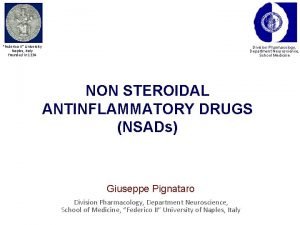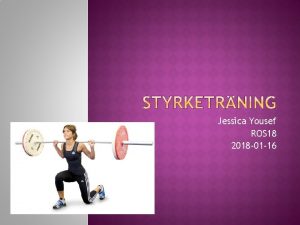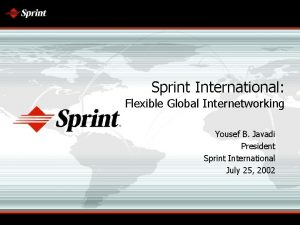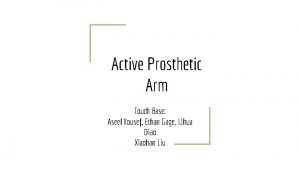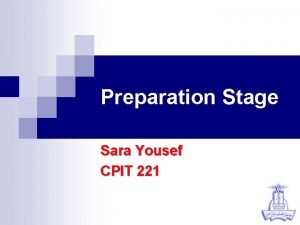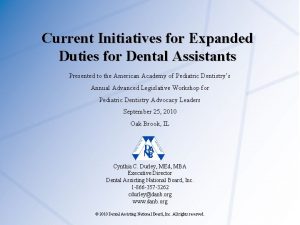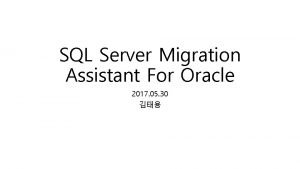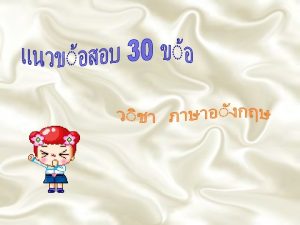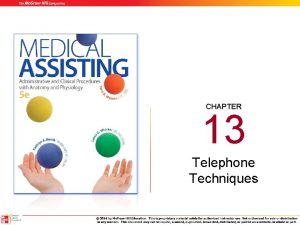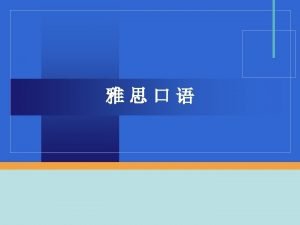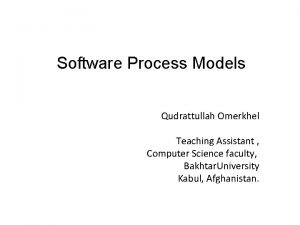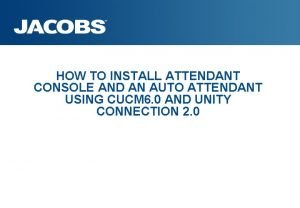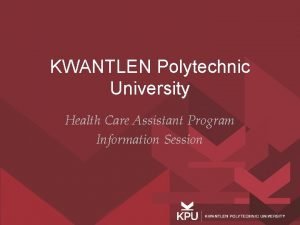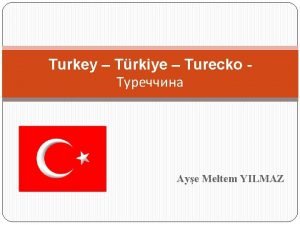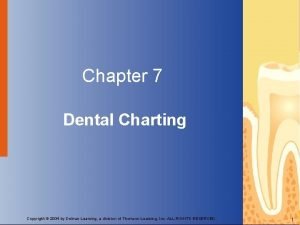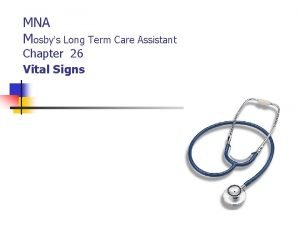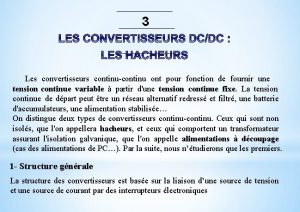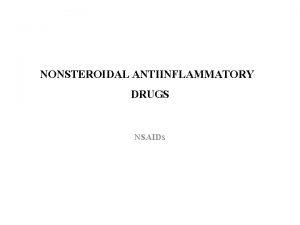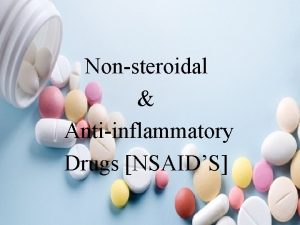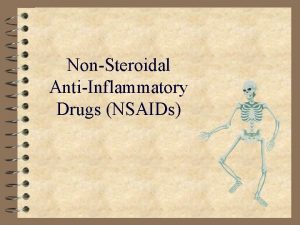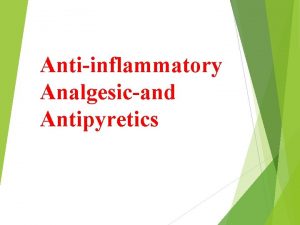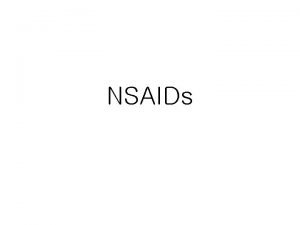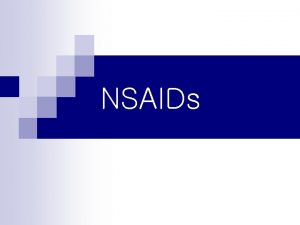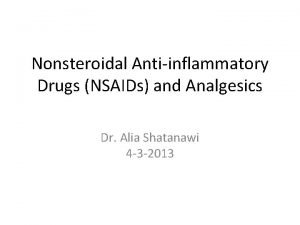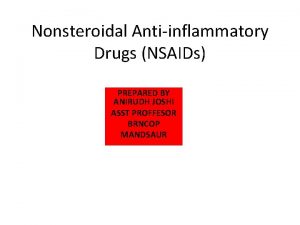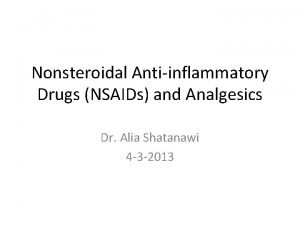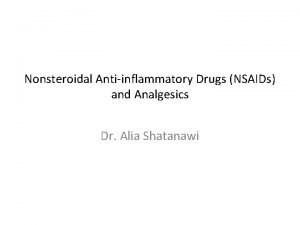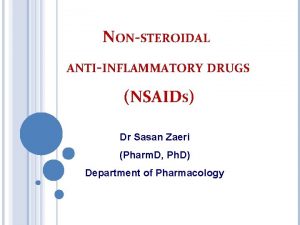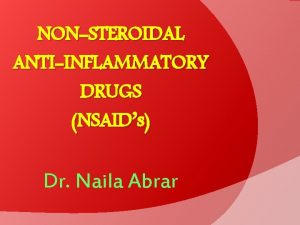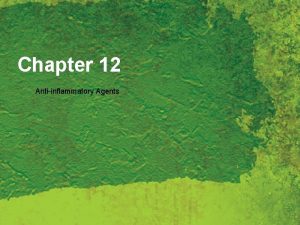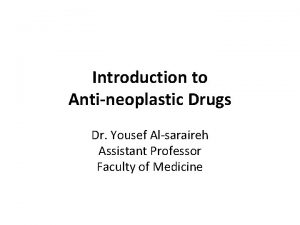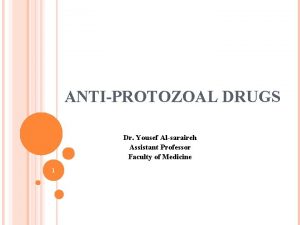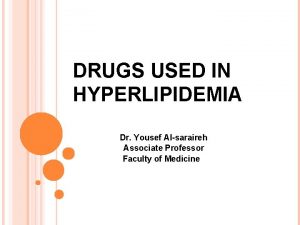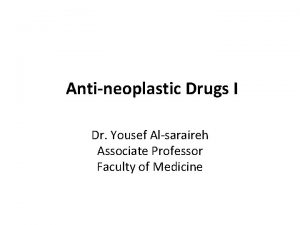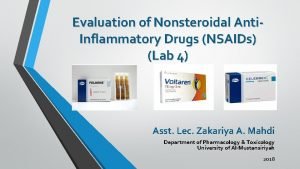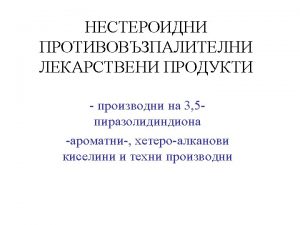Nonsteroidal antiinflammatory drugs NSAIDs Dr Yousef Alsaraireh Assistant






































- Slides: 38

Non-steroidal anti-inflammatory drugs (NSAIDs) Dr. Yousef Al-saraireh Assistant Professor Faculty of Medicine 1

Definition Ø NSAIDs are class of drugs having the capacity to suppress the signs and symptoms of inflammation (anti-inflammatory effect). Ø They also exert analgesic and anti-pyretic effects. Ø Therefore, these drugs are mainly indicated to relief pain, swelling, redness and stiffness caused by inflammation. 2

Inflammation Ø Inflammation is the body response to an injurious stimulus (e. g. , infections, chemicals, or physical injuries) Ø Inflammation is triggered by release of chemical mediators from injured tissues and migrating cells such as WBC. Ø These chemical mediators are histamine, bradykinin, interleukins and the most important are EICOSANOIDS such as prostaglandines and leukotrienes 3

Prostaglandines (PGs) Ø PGs are fatty acid derivatives produced by all tissues Ø PGs act locally on the site of synthesis where they rapidly metabolized to inactive products. Ø On the cell damage, PGs are formed from the primary precursor Arachidonic acid (AA) by enzymes called Cyclooxygenases (Cox) 4

5

Ø Under various stimuli, AA is liberated from phospholipids of cell membranes by the action of lysosomal enzymes (Phospholipase A 2) Ø AA is then oxidized by COX leading to formation of PGs (e. g. PGD 2 , PGE 2, PGF 2 a), Thromboxanes (TX) e. g. TX A 2, and Prostacycline (PG I 2). Ø There are two isoforms of Cox: 1. Cox-1 2. Cox-2 6

Cox-1 Ø Cox-1 is considered a house keeping enzyme, constitutively expressed in most tissues throughout body Ø it catalyzes the formation of PGs involved in continuous regulation of physiologic functions such as 1. Gastric protection 2. Vascular homostasis & platelet aggregation 3. Kidney function 7

Cox-2 Ø Cox-2 is an inducible enzyme produced by inflammatory cells Ø It catalyzes production of pro-inflammatory PGs as mediators for inflammation Ø It is constitutively expressed in brain (fever induction and pain transmission), kidney (water & electrolyte homeostasis) and bone. Ø It’s expression is elevated at other sites during state of inflammation 8

Mechanism of action Ø NSAIDs act by inhibiting cyclooxygenase enzymes that catalyze first step in prostanoids biosynthesis, leading to decreased PGs synthesis with both beneficial & unwanted effects Ø Most NSAIDS are non-selective i. e. they inhibit both Cox-1 and Cox-2. Their anti-inflammatory action is due to inhibition of Cox-2, but side effects are due to inhibition of Cox-1 9

Therapeutic uses 1. Anti-inflammatory effect: Ø To treat inflammatory disorders e. g. Rheumatoid arthritis (RA), osteoarthritis (OA), gout, and musculoskeletal disorders NSAIDs decrease inflammation by decreasing PG production, but inflammation is not abolished because of presence of other inflammatory mediators Ø NSAIDs give some relief of pain, swelling, and stiffness. 10

2. Analgesia: Ø NSAIDs relieve mild to moderate pain e. g headache, dental pain, muscle or joint pain and soft tissue pain. Ø NSAIDs are not effective for severe pain NSAIDs decrease pain by decreasing production of PGs responsible for sensitization of nerve endings to action of chemical mediators (bradykinin & histamine) in inflamed tissue 11

3. Antipyretic effect: Ø NSAIDs decrease pyrexia due to inflammation, trauma, allergy but has no effect on the normal body temperature Ø Fever occurs when Macrophages, at site of inflammation, produce interleukin-1 (IL-1) which enters CNS to act on hypothalamus to stimulate PGE 2 synthesis; this PGE sets the hypothalamus thermostat at a higher level and thus produces pyrexia NSAIDs decrease pyrexia by inhibiting the PGs synthesis in hypothalamus, therefore setting thermostat at lower level 12

4. Anti-platelet effect: Ø Aspirin is indicated to reduce the incidence of myocardial infarction (MI), transient ischemic attacks (TIA) & embolic strokes that all caused by vascular thrombosis due to platelet aggregation. Ø Aspirin at low dose (80 -100 mg/d ) irreversibly inhibits the thromboxane A 2 (TXA 2) synthesis inside platelets via acetylation of Cox-1. (TXA 2 is a powerful platelet aggregator and a vasoconstrictor) Ø The decrease in TXA 2 leads to inhibition of platelets aggregation , and prevents thrombosis in arteries of brain (cerebral), heart (coronary), and limbs. 13

Adverse effects 1. GIT: Ø PGs have gastroprotective effect: inhibiting acid secretion, promoting secretion of mucous Ø NSAIDs decrease formation of protective PGs in gastrointestinal mucosa and therefore leading to GI irritation, GI bleeding and ulcers Ø These side effects can be treated by coadministration of Proton-pump inhibitors (PPIs), H-2 antihistamines & prostaglandin analogue (misoprostol) 14

2. Renal effects: Ø NSAIDs decrease renal blood flow due to inhibition of synthesis of renal PGs eg. PGI 2 Ø This results in retention of sodium and water and may cause edema. This makes heart failure or hypertension more worse. Ø Chronic use of NSAIDs (esp. multiple of them ) may lead to interstitial nephritis progressing to renal failure 3. Bleeding : Ø Because of platelet dysfunction especially with aspirin, bleeding time is prolonged. Ø Carful should be taken before surgery and in patients administering anti-coagulant 15

4. Pregnancy : Ø NSAIDs should be avoided because they can cause : a. delayed onset of labor , and prolonged labor b. premature closure of the ductus arteriosus in infant c. increased risk of bleeding 5. CNS : Ø Headache, vertigo, dizziness, confusion & depression 16

6. Hypersensitivity: Ø Vasomotor rhinitis, edema, asthma, urticaria flushing, hypotension and shock. 7. Liver toxicity : Ø With large doses esp. with prolonged use or in patients with liver disease 8. Skin effects : Ø Specially with topical use: photosensitivity, allergy e. g. urticaria, & other skin rashes. 17

Drug interactions 1. Many NSAIDs are highly bound to plasma albumin after their absorption from GIT. Accordingly, they may displace other drugs that are also bound to plasma albumin (e. g. warfarin , hypoglycemic sulphonylureas drugs) to become free and active in plasma which may result in toxic effects of these drugs 2. NSAIDs , mainly due their renal actions , may antagonize the effect of diuretics as well as antihypertensive drugs like beta-adrenoceptor blockers & ACE (Angiotensin-Converting Enzyme) inhibitors 18

Contraindications Ø NSAIDs use should be avoided: Peptic ulcer Renal impairment Cardiac failure Bleeding disorder Pregnancy Ø Caution is needed in patients with bronchial asthma or hypertension Ø NSAIDs should be avoided or used with caution in liver disease as all NSAIDs are metabolized by liver 19

Classification of NSAIDs Ø Based on their anti-inflammatory action: A. Weak or No clinically useful anti – inflammatory action eg. Paracetamol B. Mild to moderate anti-inflammatory action eg. Aspririn C. Marked Anti-inflammatory action eg. Diclofenac 20

A. Weak or No clinically useful anti – inflammatory action 1. Paracetamol or Acetaminophen (Panadol): Ø Paracetamol has an analgesic and antipyretic properties with a devoid of anti-inflammatory effect. Ø It inhibits PGs in brain and therefore acts as analgesic and antipyretic but it has less effect on peripheral PGs responsible for inflammation. It probably act on another enzyme, ( COX 3 ), in CNS, which may be a splice variant product of COX 1 gene, to produce analgesic or antipyretic effects. 21

Ø It is a weak inhibitor of COX 1 or COX 2 In periphery , it has no significant anti-inflammatory action. In tissues , p-aminophenols trap free radicals which are important formation of hydro-peroxidase that is essential for the activity of COX. In inflamed tissues, large amounts of peroxide radicals are produced which swamp this action of p-aminophenols ; thus hydroperoxidase continue to be formed, and COX 2 remain active in inflammatory cells at inflamed sites Ø It neither affects platelet function nor GI irritation Ø The oral dose for adults as analgesic or antipyretic is 0. 5 -1 g X 3/d. Ø Maximum daily dose is 4 g 22

Ø Therapeutic uses: 1. It is effective in mild to moderate pain e. g. headache, dysmenorrhoea (menstrual pain) 2. It is a substitute for analgesic & antipyretic effects of aspirin particularly in A. children with viral infection B. patients with peptic ulcer since it causes no gastric irritation Ø Adverse effects include: 1. Skin rash occurs infrequently 2. Hepatic and renal necrosis with large and prolonged doses (quinone metabolite). Antidote is N- acetyl cysteine binds and inactivates the toxic quinone metabolite 23

B. Mild to moderate anti-inflammatory action 1. Aspirin (Acetylsalicylic acid) Ø It is a weak organic acid and is unique among NSAIDs. Ø Mechanism of action: Aspirin Irreversibly inhibits Cox by acylating active site of enzyme, so preventing formation of thromboxane, prostacyline & other PGs. Ø Other NSAIDs are reversible inhibitors of Cox 24

Ø Therapeutic uses: 1. Anti-inflammatory use : Ø RA, OA and other inflammatory joint disease. Ø Dose is 4 -6 g / d in 3 -4 divided doses 2. Analgesic and anti-pyretic use: Ø Fever, headache, toothache, and muscular and joint pain Ø Dose is 325 -650 mg X 3 / d 3. Anti-platelet use : Ø Low dose of aspirin 80 -100 mg daily are used to prophylactically decrease incidence of transient ischemic attacks (TIAs) & strokes 25

Ø Adverse effects: 1. GIT: Ø Epigastric distress, nausea, vomiting and bleeding 2. Bleeding tendency 3. Hypersensitivity: Ø About 15% of patients develop allergy 4. Specific adverse effects : A. Reye’s syndrome: Ø Use of Aspirin in children with viral infections (e. g. measles, influenza, or chickenpox) may rarely cause Reye’s syndrome (extensive fatty infiltration of liver with liver damage and failure) 26

B. Salicylism : Ø It is mild salicylic acid intoxication. Symptoms include: confusion, tinnitus, deafness, sweating, vomiting and others Ø Contraindications: Ø Aspirin should be avoided in patients with peptic ulcers, asthma and febrile children due to viral infections. Ø Drug interactions: Ø Aspirin should be avoided or used with caution in patients taking warfarin, phenytoin or valporic acid. Aspirin displace these drugs from binding of plasma protein resulting in high drug concentrations and therefore toxicity 27

2. Propioinc acid derivatives Ø This class includes Ibuprofen , ketoprofen and Naproxen Ø All are reversible non-selective inhibitors of Cox that inhibit synthesis of PGs Ø All possess anti-inflammatory, analgesic & antipyretic activities Ø They cause less GI side effects than aspirin and therefore are preferred for chronic use in inflammatory joint diseases and in musculo-skeletal disorders Ø Most common adverse effects ranges from GI dyspepsia to bleeding 28

3. Fenamates : Ø Main example is Mefenamic acid (ponstan) Ø No clear advantages over other NSAIDs and may cause GI side effects. It has little anti-inflammatory action (milde). Ø Indications: Ø Short-term treatment of pain in soft-tissue injuries, dysmenorrhea, and in RA and OA Ø Adverse effects: Ø Severe diarrhea associated with inflammation in bowel and hemolytic anemia 29

C. Marked Anti-inflammatory action 1. Arylacetic acid derivatives : Ø Main example is Diclofenac (Voltaren) Ø It is a potent Cox inhibitor with anti-inflammatory, analgesic & antipyretic activities (accumulates in synovial fluid) Ø It is potent than indomethacin or naproxen Ø Indications: Ø long-term treatment of RA and OA Ø short-term treatment of acute musculoskeletal pain, postoperative pain, and dysmenorrhea Ø Side effects: a. GI irritation to bleeding b. Fluid retention, edema, and rarely impairment of renal function 30

2. Acetic acid derivatives: Ø Indomethacin (Indocin) and sulindac Ø All possess anti-inflammatory, analgesic and antipyretic properties Ø They are not generally used to lower fever A. Indomethacin : Ø It is more potent than aspirin, but toxicity limits use to short-term dosing Ø Indications: Ø It is useful in treatment of RA, OA, ankylosing spondylitis (AS), and acute gout 2. Closure of patent ductus arteriosus in neonate : given by IV infusion within 72 h of birth 31

Ø Side effects : Ø CNS : ( 35 -50%)headache, dizziness and others Ø GI disturbances: Diarrhea, ulcers, bleeding B. Sulindac : Ø This is a pro-drug ; it is converted to active sulfide metabolite in liver Ø It is less potent than indomethacin Ø It causes less adverse effects than indomethacin & other NSAIDs Ø It is useful in treatment of RA, OA, AS and acute gout 32

3. Oxicam derivatives : Ø Piroxicam (Feldene) and meloxicam (Mobic) Ø Able to inhibit Cox-1 and Cox-2 but meloxicam shows preferential COX-2 selectivity (preferential Cox-2 inhibitor) Ø Are used to treat RA, OA, AS Ø They have long half-life, once daily Ø Piroxicam has more GI side-effects than most other NSAIDs Ø Meloxicam has significantly less GI side-effects compared to piroxicam and other NSAIDs 33

4. Selective Cox-2 inhibtors (coxibs) Ø Celecoxib, rofecoxib, valdecoxib and etoricoxib Ø Analgesic and anti-inflammatory properties by selectively inhibiting the Cox-2 biosynthesis Ø Hypothesis: Cox-2 isoform is up regulated in the site of inflammation mediating inflammation by catalyzing the biosynthesis of PGE 2 and PGI 2 , and these PGs are also formed by Cox-1 in gastric epithelium where they act as cytoprotective mediators. 34

Ø proinflammatory PGs are inhibited and simultaneously sparing the PGs catalyzed by Cox 1 necessary for physiologic functions Ø They exert anti-inflammatory properties with less or none of typical adverse effects associated with NSAIDs treatment on GIT and kidney. Ø Indications: Ø Patients who require chronic use of NSAIDs & are at high risk for NSAIDs-induced ulcer 35

Ø Inflammatory and painful conditions such as RA, OA, headache, menstrual, dental and postoperative pain Ø Long acting, once daily Ø Side effects: Ø Most common abdominal pain, diarrhea, dyspepsia Ø Hypersensitivity: sulphonamide hypersensitive patients (urticaria, angioedema, sweet, rash. . . Etc) 36

Ø Contraindications: Ø COX-2 inhibitors should be avoided in patients with chronic renal insufficiency, severe heart disease & hepatic failure. Ø Rofecoxib and valdecoxib was withdrawn from market because its use was associated with increased risk of stroke, heart attack, and sudden cardiac death. 37

38
 Chapter 44 antiinflammatory and antigout drugs
Chapter 44 antiinflammatory and antigout drugs Acetic acid derivatives
Acetic acid derivatives Pain goals
Pain goals Acute gastritis
Acute gastritis Cpit 110
Cpit 110 Jessica yousef
Jessica yousef Yousef javadi
Yousef javadi Aseel yousef
Aseel yousef Sara yousef
Sara yousef Leena yousef
Leena yousef Sara yousef
Sara yousef Sara yousef
Sara yousef Efda definition
Efda definition Siri dahl personal assistant
Siri dahl personal assistant Sql server migration assistant for sybase
Sql server migration assistant for sybase Shop assistant welcome madam
Shop assistant welcome madam Telephone techniques medical assistant
Telephone techniques medical assistant Chapter 2 the nursing assistant and the care team
Chapter 2 the nursing assistant and the care team Ibm support assistant download
Ibm support assistant download Home assistant fan template
Home assistant fan template Rop santa cruz
Rop santa cruz D-kefs scoring assistant
D-kefs scoring assistant Assistant computer control
Assistant computer control Cisco attendant console standard
Cisco attendant console standard Executive assistant conference 2019
Executive assistant conference 2019 Assistant director vicky
Assistant director vicky Role of a teaching assistant
Role of a teaching assistant What are the duties of assistant scorer?
What are the duties of assistant scorer? Cashflow assistant
Cashflow assistant Ethical and legal issues affecting the nursing assistant
Ethical and legal issues affecting the nursing assistant Heidi frechette
Heidi frechette Kpu health care assistant
Kpu health care assistant Qcm module 1 assistant maternel
Qcm module 1 assistant maternel Good afternoon assistant
Good afternoon assistant Comenius assistant
Comenius assistant Dental surfaces chart
Dental surfaces chart The assistant chapter 26
The assistant chapter 26 How to email a professor
How to email a professor Hacheur réversible en courant
Hacheur réversible en courant

